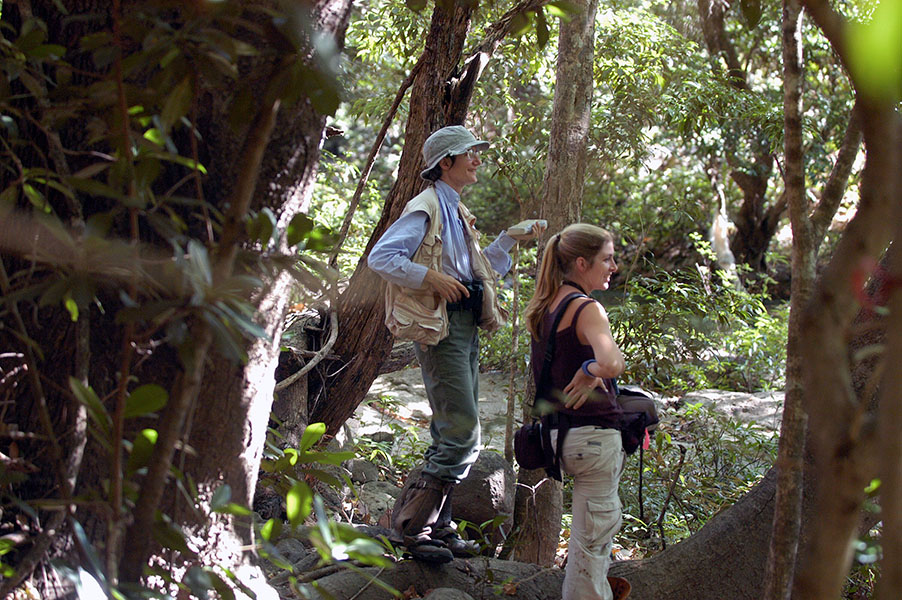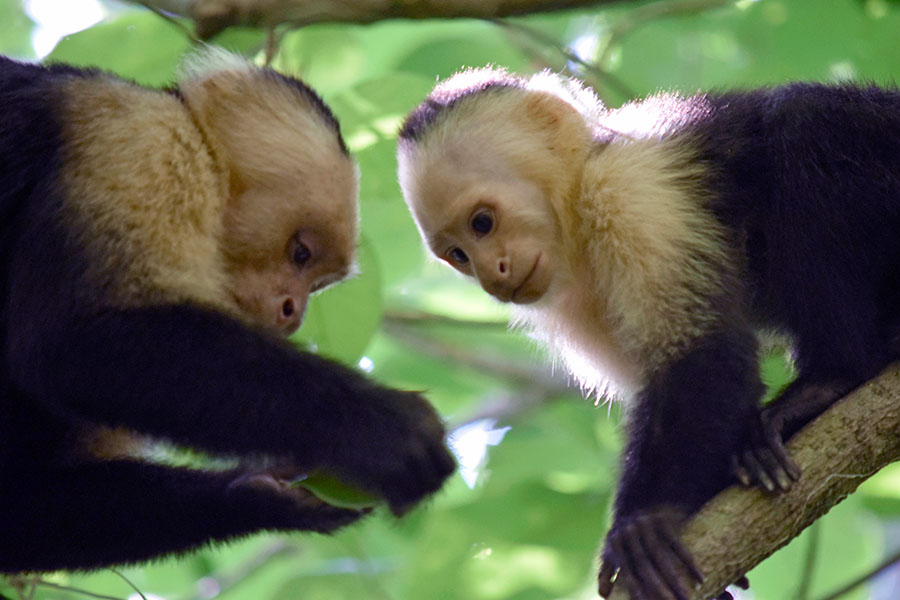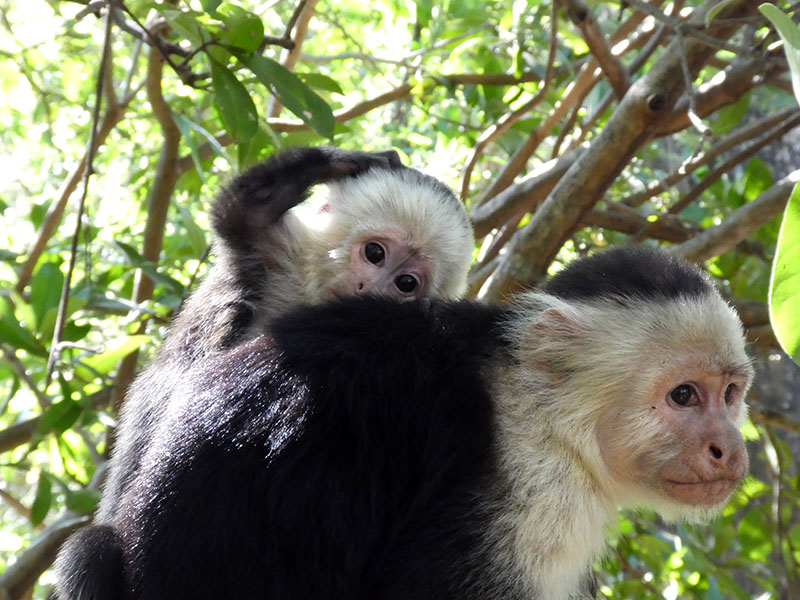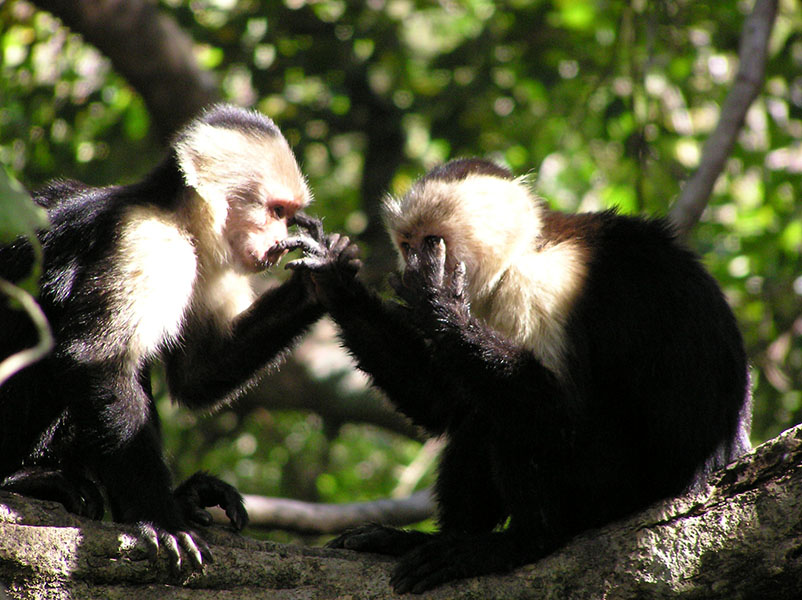Meet the capuchin monkey: Curious, creative and vengeful
UCLA’s Susan Perry has devoted decades to studying the fast-motion life of these New World primates and learning how the young acquire the skills they need to thrive
Support sound science and smart stories
Help us make scientific knowledge accessible to all
Donate today
Primatologist Susan Perry of UCLA has spent much of the past 35 years studying the complex social lives of white-faced capuchin monkeys, at a field site she established in one of the remaining patches of dry forest in northwestern Costa Rica.
Over time, she has grown more and more fascinated by the question of how young capuchins acquire all the knowledge and skills they need to survive and thrive in their natural and social environment, and the amusing mistakes they make along the way. Perry’s work has revealed that young capuchins, like human children, are uniquely adapted to learn, and that our two species have plenty of other things in common as well, such as a tendency to engage in bizarre ritual-like behavior that seems to have no other function than strengthening bonds between individuals.
Like humans, capuchins are curious, manipulative, almost obsessively social and not to be messed with, and — as Perry has explained in two articles in the Annual Review of Anthropology — there is a lot we can learn from them on how culture, including our own, evolves.
This conversation was edited for length and clarity.
How and why did you end up working on white-faced capuchin monkeys?
In graduate school, I remember being really intrigued by the evolution of intelligence. Like us, capuchins have evolved an extremely large brain relative to their body size. Back then — this was the late 1980s — we hardly knew anything about capuchins, especially their social behavior. So I decided to start my own long-term study site, at Lomas Barbudal Biological Reserve in Costa Rica.
What I didn’t think about was that, because it was so hilly and the terrain was really awful, it would be hard to retain long-term staff or collaborators — to find enough people to stick with me on this very hard slog of climbing cliffs and wading through rivers all day.
But rather than shopping around for a more convenient place, I just started the work. I was too excited to meet the capuchins.
I have tried to watch capuchins go about their business in zoos, and to me, it seems they’re operating in fast-forward — at a pace too fast for my poor brain to process. How are you able to comprehend and record all of this detailed information on their behavior?
It’s like watching cartoon characters, fast action all day. It took a few months before I felt like I had grasped the full behavioral repertoire. I was adding new behaviors all through the first year. But the capuchins invent stuff all the time, and that’s part of what I’m interested in. So I’m always on the lookout for new inventions, because they’re very creative. I always have a recording device in one hand to record new inventions.
Nowadays, we work in teams. We always need one person to have their eyes glued to the monkeys, jabbering as fast as they can into a recording device, while the other person tries to type the codes into a phone as much as they can. Before a new assistant comes to the field, I give them several hundred codes to memorize, and they have to learn speed typing too.
It’s one thing to be sitting in a chair speed typing, but it’s quite another to be speed typing while going through a barbed wire fence or crossing a river by boulder-hopping. It takes at minimum three months of dawn-to-dusk training.

Primatologist Susan Perry and her field site manager at the time, Hannah Gilkenson, look for the capuchin monkeys they study in Lomas Barbudal, Costa Rica, in 2005.
CREDIT: LOMAS BARBUDAL MONKEY PROJECT ARCHIVES
Have you been able to document any new inventions spreading through the population?
Well, we’re watching monkeys all day, every day, but we obviously aren’t watching every monkey all day, every day. So when we see something new, we can’t say for sure that they’d never ever done it that way previously. But we can establish patterns of who does something first, as far as we know, of who looks at whom, and then record any changes in the way things are done over time.
For example, we did a study on the empanada-shaped fruits of the Panama tree, Sterculia apetala. This is a very hard food to process. It takes knowledge, strength, agility. Some monkeys take over an hour to process one. Some never master it. Others can do it in 10 seconds.
There is one section of the study area that does not have any of these trees. We had some adult monkeys that had learned how to process these fruits in one place, and then moved into an area that did not have any of these fruits. So newborns in that group had not had access to this food before.
Brendan Barrett, my grad student at the time, collected fruits by climbing the trees and then brought them to the group where the infants had never seen them. We were able to record everything they did with these fruits and every time they had an opportunity to handle them or see them being handled.
Brendan then looked at the independent contributions of two kinds of learning on the young monkeys’ fruit processing skills: the trial-and-error learning they do on their own, and the social learning they do by watching more experienced monkeys. It turned out both types of learning were important. Everyone figured out pretty quickly that a male called Napoleon — a total misnomer because he is very timid and normally gets no respect — knew how to process these fruits quickly. So they were all watching him, and his technique soon became very popular.

To learn how to turn difficult-to-process fruits into food, young white-faced capuchins pay close attention to the actions of more experienced adults, favoring the most skilled ones. This infant is watching the group’s alpha male.
CREDIT: PATRICK KOLENCE
Do young monkeys only copy successful individuals, or do they also make mistakes?
They do make mistakes sometimes. There are some fruits that are covered in horrible hairs that really hurt, and monkeys will scrub them against a branch to remove the hairs. But confusingly for the infants, capuchins also rub nasty substances on their fur as an insect repellent. So sometimes when infants see scrubbing, they seem to think, “Oh, it’s one of those things you rub all over your body,” and they grab one of these prickly fruits and rub it all over their body — and then they must be very itchy all day.
Those are misunderstandings. But occasionally, they also do learn things from each other that are likely harmful. There are several families that enthusiastically rub chewed-up cashew fruits all over their bodies. One of these families seems to be allergic, however, so they break out when they fur-rub with this toxin. But because there’s a delay between when they do it and when they break out, they don’t ever seem to catch on to the link. They don’t die from it, but they do get bloody and raw and itchy and disgusting until the fruits are out of season.
Are young monkeys learning in a similar way to human infants, or are there differences?
We did find something that fits with work on humans, which is that young monkeys are more flexible. They like to try new things, and they stick a lot of things in their mouths the way human infants do. They are also more prone to watch what others are doing and incorporate what they saw into what they do next.
And they will often go over and stare at someone handling a food item that is rare or hard to process, indicating that they’re interested in learning about things they don't know about that might be good to eat. So it seems they’re structuring their observations in a way that will give them information about how to do difficult or important things.
I think one of the differences with human development, on the other hand, is that capuchin infants are very proactive in the way they seek information, and in intrusive ways — like: Can I touch this? Can I taste that? What are you doing? It looks like a big bother, but the adults are pretty indulgent and tolerant of infants.
Initially, infants don’t have very good information about the power structure of the group. So they will threaten the alpha male and do things that they won’t be able to get away with later in life. Yet no one grabs an infant by the tail and goes, “Listen, kid, it’s time for you to learn how things are done around here,” or whatever. No one is correcting stupidity in capuchins. Unless there is a predator or an enemy male around — then adults will go grab the infants.
Is everyone taking care of the kids together, then, or is each adult minding their own?
Capuchins have what we call alloparenting — adults who aren’t the parents taking care of infants — and even allonursing. We’ve seen orphans being adopted and surviving on milk they get from females that aren’t their mothers.
Around three months of age, infants start getting off mom’s back and climbing onto other adults’ backs. Especially months three to six, they’re still regularly on someone’s back, but it’s more often the alloparents than the mother. There is a lot of initiation from infants to alloparents, but adults may also come over and actively crouch and go, “Get on my back, let’s go have fun.” Adults are often very eager to do this: They can be really begging to be allowed to carry a baby for a while.
There is also active competition among males — usually juveniles, adolescents or subordinates — to handle particular babies. They’ll come and check an infant’s genitals first, since they usually want to alloparent the male infants specifically. We think this is because all males will move out of the group eventually, and they are bonding with younger males that might join them when they migrate.

Older infants spend increasing time on the backs of group members other than their mothers, which allows them to learn from, and bond with, a variety of adults. Many adults are keen to carry the infants around. This particular male infant (3 months old at the time the photo was taken) was so popular with males competing to carry him that his mother had a hard time gaining access to nurse him. Young males like to spend time with male infants because they’ll need allies when migrating to a new group.
CREDIT: SUSAN PERRY
Do capuchins go through a sort of adolescence as well?
One interesting thing is that as they get older, juveniles start getting interested in what we call bond-testing rituals, like prying each other’s mouths open, sucking on appendages, sniffing or clasping hands, drumming on each other’s bodies. The weirdest such ritual is what we call eyeball poking, where they put their fingers into each other’s eye sockets. That is just such a bad idea if you need depth perception to live in the trees, to have these long, dirty nails touching your eyeball.
That remains the most puzzling invention that spread, and it has endured for years and years. But I think the fact that it’s risky may be the point: You would really only do this with an individual you trust.
There seems to be an initial negotiation about who does what, and then two monkeys will finally settle into this ritual together. For example, for the last few years of their relationship, Minstrel would always take Mead’s fingers and insert them into her nose and mouth, and Mead would lie on her side. And then that would be their thing, you know. There is another pair where Shenzi will chew on Legolas’s ear and Legolas will reach around and massage the eyeball of Shenzi while he does that.
It’s a very uncomfortable-looking thing. But they do this over and over in the same pattern, week after week.

White-faced capuchins are famous for bizarre bonding rituals that may develop between specific individuals. Some even poke their fingers into the eyes of others, which carries a risk of damage or infection. Perhaps that is what makes the behavior a convincing expression of trust.
CREDIT: SUSAN PERRY
Why would this kind of bonding be so important, do you think?
When a new male comes in and takes over as a dominant, he will often kill all the infants. So I think a lot of what is going on in capuchin social groups is females banding together to support the alpha male to make sure he is not overthrown and their offspring will survive. Successful alpha males can remain in power at least 18 years, and the stability they provide means the infants will have a much richer social environment and a better chance at success in life because they and their playmates don’t have this threat of infanticide.
Even though capuchins will bicker a lot, whenever an outside threat arises, they are totally united. They could have just had a big fight and then a male from another group comes over, and they’re all helping each other to fight him off. There is a huge “common enemy” psychology in capuchins. To try to solve their own little squabbles within their group, they will occasionally even seek a common enemy, sometimes a really absurd one, like a pile of poop or something else to jointly threaten.
Intriguingly, though, sometimes after an intergroup encounter appears to be over and the alpha males have left the scene, the subordinate males of each group will come back to the site of the encounter and they’ll do nicer things, like dance with each other or even have sex. Male-male sex is super common in capuchins, and it looks basically the same as the behaviors involved in conceptive sex.
I think they’re feeling one another out: “Right now, I’m loyal to this group, but if I never get to mate over here, maybe I’ll come join your group. How would you treat me?” That kind of thing.
Do they show similar resolve when facing predators?
Oh yes, they aren’t afraid of anything, not even big cats. Like humans, they are their own worst enemy — with humans being the number two threat. I think, in general, they’re appropriately cautious of humans. They have a special human alarm call, and when they’re doing it, they’re typically ducking behind tree trunks and just peeking out occasionally, which is the right thing to do in that context.
Though I sometimes feel like they could leave a little earlier in the face of danger: They’re kind of rubberneckers — they like to know about dangers.
And they are almost always on the offensive. The only animal they’re nice to is agoutis, and I think that's because they benefit from the agoutis’ alarm calls. So they don’t pick on those, but they do like to mess with any other creatures.
And they make terrible pets. I’m regularly getting emails from people who adopted a baby capuchin and now it’s an adolescent, and they’re like: What do I do? Well, you screwed up. You should never have adopted a capuchin. You shouldn’t bring them into your home. They’re wild creatures. They have a very feisty temperament. Yes, they’re gonna trash your home. Yes, they’re gonna bite you when they’re displeased with you.
A lot of species have formal submissive gestures after a fight to acknowledge that they’ve lost. Capuchins never acknowledge they’ve lost. They just back away, and they’re like, “I’m getting revenge later.” That’s the capuchin attitude.
10.1146/knowable-021925-1
TAKE A DEEPER DIVE | Explore Related Scholarly Articles




